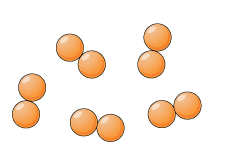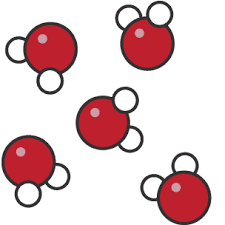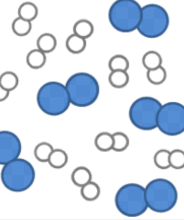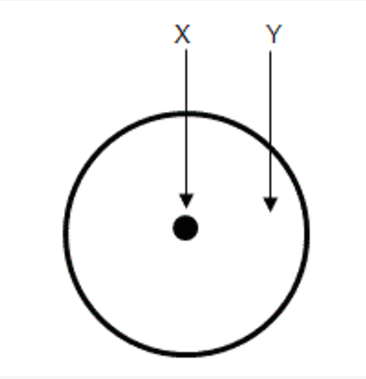Year 9 Chemistry Mid Unit Revision

.
- 1.
The positively charged particle in an atom is the:
- A.
Protons
- B.
Neutrons
- C.
Electrons
- D.
Orbitals
Correct Answer
A. ProtonsExplanation
The positively charged particle in an atom is the proton. Protons are found in the nucleus of an atom and have a positive charge. They are equal in number to the number of electrons in a neutral atom, determining the atomic number and the identity of the element. Neutrons, on the other hand, have no charge and are also found in the nucleus. Electrons have a negative charge and orbit around the nucleus. Orbitals, on the other hand, are regions in space where electrons are likely to be found.Rate this question:
-
- 2.
The maximum numbers of electrons in the first four energy levels of an atom are:
- A.
2, 8, 8, 18
- B.
2, 4, 6, 8
- C.
2, 14, 26, 28
- D.
2, 2, 8, 12
Correct Answer
A. 2, 8, 8, 18Explanation
The maximum number of electrons in the first energy level is 2, as it can hold a maximum of 2 electrons. The maximum number of electrons in the second energy level is 8, as it can hold a maximum of 8 electrons. The maximum number of electrons in the third energy level is also 8, as it can hold a maximum of 8 electrons. The maximum number of electrons in the fourth energy level is 18, as it can hold a maximum of 18 electrons.Rate this question:
-
- 3.
When an atom loses an electron, it becomes a:
- A.
Negative ion
- B.
Positive ion
- C.
Polyatomic ion
- D.
Neutral ion
Correct Answer
B. Positive ionExplanation
When an atom loses an electron, it becomes a positive ion. This is because the atom now has more protons than electrons, resulting in a net positive charge. The loss of an electron creates an imbalance in the atom's charge, making it positively charged.Rate this question:
-
- 4.
Which of the following terms could be used to describe the matter in this image?
- A.
Single atoms
- B.
Molecules
- C.
Compound
- D.
Element
Correct Answer(s)
B. Molecules
D. ElementExplanation
The matter in the image can be described as molecules because it shows multiple atoms bonded together. Additionally, it can also be described as an element because it consists of only one type of atom.Rate this question:
-
- 5.
Which of the following terms could be used to describe the matter in this image?
- A.
Single atoms
- B.
Molecules
- C.
Compound
- D.
Element
Correct Answer(s)
B. Molecules
C. CompoundExplanation
The matter in the image could be described as molecules and compounds. Molecules refer to a group of atoms bonded together, and compounds are substances made up of two or more different elements chemically bonded. Since the image shows multiple atoms bonded together, it can be inferred that it represents molecules. Additionally, if the atoms in the image are of different elements, then it can also be considered a compound.Rate this question:
-
- 6.
Which of the following terms could be used to describe the matter in this image?
- A.
Single atoms
- B.
Molecules
- C.
Elements
- D.
Mixture
Correct Answer(s)
B. Molecules
C. Elements
D. MixtureExplanation
The matter in the image could be described as molecules because it shows multiple particles bonded together. It could also be described as elements because it consists of different types of atoms. Additionally, it could be described as a mixture because it contains a combination of different substances.Rate this question:
-
- 7.
Which of the following word equations is correct for a reaction between copper and oxygen?
- A.
Copper + oxygen -> carbon dioxide
- B.
Copper + oxygen -> copper sulfide
- C.
Copper + oxygen -> copper oxide
- D.
Copper + oxygen -> copper iodide
Correct Answer
C. Copper + oxygen -> copper oxideExplanation
The correct answer is "Copper + oxygen -> copper oxide." This is because when copper reacts with oxygen, it forms copper oxide. The other options are incorrect because they do not represent the correct products of the reaction.Rate this question:
-
- 8.
The chemical symbols of chlorine, potassium, copper, sodium, nitrogen and iron in order are:
- A.
Cl, P, Co, So, Ni, I
- B.
Cl, K, Cu, Na, N, Fe
- C.
Cl, K, Co, So, N, Fe
- D.
Cl, Po, Co, Na, N, Fe
Correct Answer
B. Cl, K, Cu, Na, N, FeExplanation
The correct answer is Cl, K, Cu, Na, N, Fe. This is because the chemical symbols of the elements chlorine, potassium, copper, sodium, nitrogen, and iron are represented by Cl, K, Cu, Na, N, and Fe respectively.Rate this question:
-
- 9.
What is a chemical compound?
- A.
A combination of two protons and two electrons
- B.
A combination of two or more chemical elements bonded together
- C.
A mixture of two or more chemical elements
- D.
Any substance that contains chemically bonded particles
Correct Answer
B. A combination of two or more chemical elements bonded togetherExplanation
The correct answer is a combination of two or more chemical elements bonded together. A chemical compound refers to a substance that is made up of atoms of different elements that are chemically bonded together. This bonding can occur through various types of chemical bonds, such as ionic bonds or covalent bonds. The combination of these elements results in the formation of a new substance with unique properties and characteristics.Rate this question:
-
- 10.
Which one of the following is a mixture?
- A.
Sea water
- B.
Distilled water
- C.
Iron oxide
- D.
Oxygen
Correct Answer
A. Sea waterExplanation
Sea water is a mixture because it is composed of various substances, including water, salt, dissolved gases, and other minerals. These components are not chemically bonded together and can be separated through processes like evaporation or filtration. Therefore, sea water does not have a fixed composition and is considered a mixture.Rate this question:
-
- 11.
Natural gas is mainly methane (CH4). What two elements are found in methane?
- A.
Cobolt and helium
- B.
Copper and holmium
- C.
Carbon and hydrogen
- D.
Carbon and helium
Correct Answer
C. Carbon and hydrogenExplanation
Methane (CH4) is composed of one carbon atom and four hydrogen atoms. Therefore, the correct answer is carbon and hydrogen.Rate this question:
-
- 12.
Which of the following statements is NOT true?
- A.
There are approximately 118 identified elements
- B.
An element is defined by its number of electrons - this is how elements are ordered in the periodic table
- C.
An element's atomic number indicates its number of protons
- D.
You can find an element's neutrons by subtracting the number of protons from the atomic mass
Correct Answer
B. An element is defined by its number of electrons - this is how elements are ordered in the periodic tableExplanation
An element is not defined by its number of electrons; rather, it is defined by its number of protons, which is indicated by its atomic number. The number of electrons can vary and is not used to order elements in the periodic table.Rate this question:
-
- 13.
Cadmium's atomic number is ______________. Thus, an atom of cadmium has ___________ protons and ___________ electrons. If cadmium has 64 neutrons, its mass number is ___________.
Correct Answer
48
48
48
112Explanation
Cadmium's atomic number is 48. This means that an atom of cadmium has 48 protons and 48 electrons. If cadmium has 64 neutrons, its mass number is 112.Rate this question:
- 14.
A beryllium atom has 4 protons, 5 neutrons, and 4 electrons. What is the mass of this atom?
- A.
5
- B.
8
- C.
9
- D.
13
Correct Answer
C. 9Explanation
The mass of an atom is determined by the sum of its protons and neutrons. In this case, the beryllium atom has 4 protons and 5 neutrons. Adding these together gives a total of 9, which is the mass of the atom. Therefore, the correct answer is 9.Rate this question:
-
- 15.
Which electronic structure is correct for an element with 17 electrons?
- A.
1,7
- B.
10, 7
- C.
2, 8, 7
- D.
2, 8, 8, 18
Correct Answer
C. 2, 8, 7Explanation
The electronic structure 2, 8, 7 is correct for an element with 17 electrons. This means that the first energy level has 2 electrons, the second energy level has 8 electrons, and the third energy level has 7 electrons. The atomic number of the element is 17, which corresponds to the number of electrons. Each energy level can hold a maximum number of electrons, with the first level holding 2, the second level holding 8, and the third level holding 8 as well. Therefore, the correct electronic structure is 2, 8, 7.Rate this question:
-
- 16.
What do the elements in a group have the same number of?
- A.
Electrons
- B.
Occupied shells
- C.
Protons
- D.
Valence electrons
Correct Answer
D. Valence electronsExplanation
The elements in a group have the same number of valence electrons. Valence electrons are the electrons in the outermost shell of an atom and they determine the chemical properties of an element. Elements in the same group have similar chemical properties because they have the same number of valence electrons, which affects how they bond and interact with other atoms.Rate this question:
-
- 17.
Which of these electronic structures belongs to a noble gas?
- A.
2
- B.
2, 7
- C.
2, 8, 2
- D.
2, 8, 7
Correct Answer
A. 2Explanation
The electronic structure of a noble gas is characterized by having a full outer shell of electrons. In this case, option 2 has only 2 electrons in the outer shell, which is the electronic structure of a helium atom, a noble gas. The other options have additional electrons in the outer shell, so they do not belong to a noble gas.Rate this question:
-
- 18.
Following the law of conservation of mass, if a student mixes 250g of sugar, 250g of water and 5g of colouring, the product will have a mass of:
- A.
500
- B.
505
- C.
503
- D.
55
Correct Answer
B. 505Explanation
According to the law of conservation of mass, the total mass of the reactants should be equal to the total mass of the products in a chemical reaction. In this case, the student mixes 250g of sugar, 250g of water, and 5g of coloring. Therefore, the total mass of the reactants is 250g + 250g + 5g = 505g. Since there are no other reactants or products mentioned in the question, the product will also have a mass of 505g.Rate this question:
-
- 19.
Which of the following statements best defines the law of conservation of mass?
- A.
Mass cannot be created but it can be destroyed under extreme pressures.
- B.
When added to a system, energy can destroy mass.
- C.
The mass of a closed system cannot change over time; mass cannot be created nor destroyed.
- D.
Mass cannot be conserved during a chemical reaction; a little bit of mass is always lost.
Correct Answer
C. The mass of a closed system cannot change over time; mass cannot be created nor destroyed.Explanation
The law of conservation of mass states that the mass of a closed system remains constant over time. This means that mass cannot be created or destroyed, only transformed or rearranged. In other words, the total mass before and after a chemical reaction or any physical process remains the same. This principle is fundamental in chemistry and physics, and it helps explain phenomena such as the balancing of chemical equations and the conservation of energy in reactions.Rate this question:
-
- 20.
Why is it important to know the 'sensitivity' of your balance when doing a conservation of matter experiment?
- A.
To eliminate all measurement errors.
- B.
To change data as necessary.
- C.
To make sure you prove the law.
- D.
To know the level of accuracy of your measurements.
Correct Answer
D. To know the level of accuracy of your measurements.Explanation
Knowing the sensitivity of your balance is important in a conservation of matter experiment because it helps determine the level of accuracy of your measurements. The sensitivity of the balance refers to its ability to detect small changes in mass. By knowing the sensitivity, you can ensure that your measurements are precise and reliable. This is crucial in a conservation of matter experiment where any slight error in measurement could lead to inaccurate results and conclusions. Therefore, understanding the sensitivity of your balance allows you to assess the accuracy and validity of your measurements in the experiment.Rate this question:
-
- 21.
In a chemical reaction, the mass of the products must always equal the mass of:
- A.
The gases released
- B.
The reactants
- C.
The solids put into the reaction
- D.
The whole system
Correct Answer
B. The reactantsExplanation
In a chemical reaction, the mass of the products must always equal the mass of the reactants. This is known as the law of conservation of mass, which states that matter cannot be created or destroyed in a chemical reaction, only rearranged. Therefore, the total mass of the reactants before the reaction must be equal to the total mass of the products after the reaction.Rate this question:
-
- 22.
Which of the following correctly match the X in this atom?
- A.
It is positively charged
- B.
It is negatively charged
- C.
It is the location of protons
- D.
It is the location of electrons
- E.
It is the location of neutrons
- F.
It contains most of the mass of an atom
- G.
It contains most of the volume of an atom
Correct Answer(s)
A. It is positively charged
C. It is the location of protons
E. It is the location of neutrons
F. It contains most of the mass of an atomExplanation
The X in this atom refers to the nucleus. The nucleus of an atom is positively charged because it contains protons, which have a positive charge. It is also the location of neutrons, which have no charge. The nucleus contains most of the mass of an atom because protons and neutrons have a much greater mass than electrons. However, the nucleus is very small in comparison to the entire atom, so it does not contain most of the volume.Rate this question:
-
- 23.
¹⁴₆C and ¹²₆C are examples of carbon:
- A.
Valences
- B.
Ions
- C.
Isotopes
- D.
Molecules
Correct Answer
C. IsotopesExplanation
The given examples, ¹⁴₆C and ¹²₆C, refer to different isotopes of carbon. Isotopes are atoms of the same element that have the same number of protons but different numbers of neutrons. In this case, the superscript numbers indicate the mass number, which is the total number of protons and neutrons in the nucleus of an atom. Therefore, the correct answer is isotopes.Rate this question:
-
Quiz Review Timeline +
Our quizzes are rigorously reviewed, monitored and continuously updated by our expert board to maintain accuracy, relevance, and timeliness.
-
Current Version
-
Oct 24, 2024Quiz Edited by
ProProfs Editorial Team -
Jun 06, 2017Quiz Created by
Elambin






